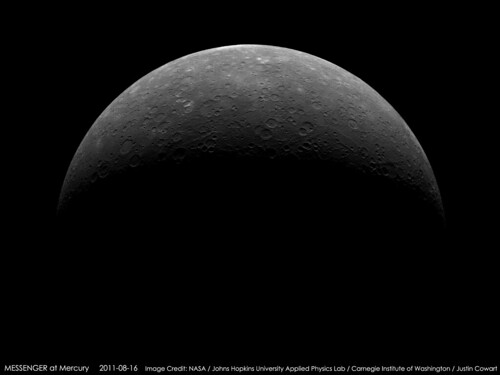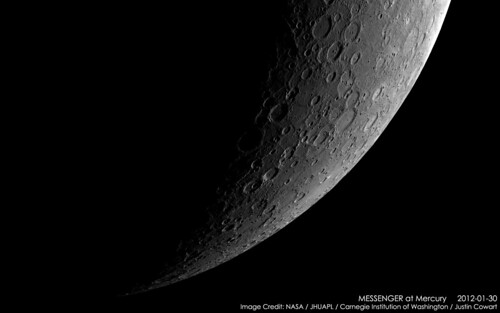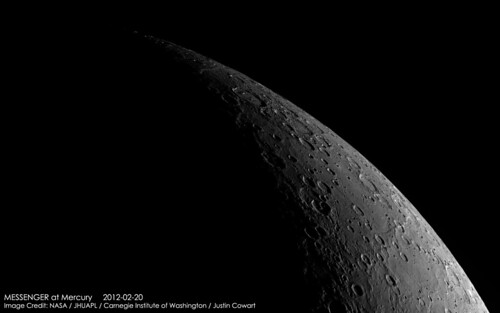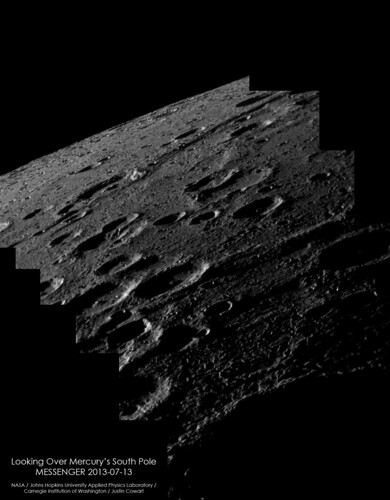MESSENGER orbital mission PDS data |

  |
MESSENGER orbital mission PDS data |
 Sep 8 2011, 05:47 PM Sep 8 2011, 05:47 PM
Post
#1
|
|
 Administrator     Group: Admin Posts: 5172 Joined: 4-August 05 From: Pasadena, CA, USA, Earth Member No.: 454 |
MESSENGER has made its first data delivery from the science phase of the mission to the PDS!
Press release: http://messenger.jhuapl.edu/news_room/details.php?id=182 Map interface: http://messenger-act.actgate.com/msgr_publ...t_quickmap.html Links to data directories: http://pds.nasa.gov/tools/subscription_ser...-20110908.shtml Have at it, guys! -------------------- My website - My Patreon - @elakdawalla on Twitter - Please support unmannedspaceflight.com by donating here.
|
|
|
|
 Sep 8 2011, 06:27 PM Sep 8 2011, 06:27 PM
Post
#2
|
|
 Senior Member     Group: Members Posts: 3648 Joined: 1-October 05 From: Croatia Member No.: 523 |
I must be doing something wrong because I can't find the new MDIS data either at Atlas search or any of the data directories.
Edit: found them here. -------------------- |
|
|
|
 Sep 8 2011, 07:30 PM Sep 8 2011, 07:30 PM
Post
#3
|
|||
 Senior Member     Group: Members Posts: 3648 Joined: 1-October 05 From: Croatia Member No.: 523 |
One snapshot, hard to find a good frame when no browse images are available yet. EDC color interpolated through CIE XYZ colorspace and converted to sRGB. Magnified 2x from original pixel scale.
A note that our Moon appears similarly red/brown (somewhat less, though), yet the eye appears to compensate for that and make it grey. To human eyes adapted to Mercury's overall hue the surface would probably look more like this: -------------------- |
||
|
|
|||
 Sep 8 2011, 08:06 PM Sep 8 2011, 08:06 PM
Post
#4
|
|
 Senior Member     Group: Members Posts: 3648 Joined: 1-October 05 From: Croatia Member No.: 523 |
-------------------- |
|
|
|
 Sep 8 2011, 08:18 PM Sep 8 2011, 08:18 PM
Post
#5
|
|
 Member    Group: Members Posts: 710 Joined: 28-September 04 Member No.: 99 |
|
|
|
|
 Sep 8 2011, 08:32 PM Sep 8 2011, 08:32 PM
Post
#6
|
|
 Senior Member     Group: Members Posts: 3648 Joined: 1-October 05 From: Croatia Member No.: 523 |
Yes, it looked familiar to me, particularly that one crater that stands out. Just my luck to stumble onto the same one out of the hundreds of other images...
-------------------- |
|
|
|
 Sep 8 2011, 09:03 PM Sep 8 2011, 09:03 PM
Post
#7
|
||
 Senior Member     Group: Members Posts: 3648 Joined: 1-October 05 From: Croatia Member No.: 523 |
If you orbited high above Mercury, this is what you might see through the window:
This should be a fair representation of actual albedo variations on the surface. -------------------- |
|
|
|
||
 Sep 9 2011, 01:24 PM Sep 9 2011, 01:24 PM
Post
#8
|
|
 Administrator     Group: Admin Posts: 5172 Joined: 4-August 05 From: Pasadena, CA, USA, Earth Member No.: 454 |
Yes, it looked familiar to me, particularly that one crater that stands out. Just my luck to stumble onto the same one out of the hundreds of other images... Of course, theirs isn't in color and saturated at the extremes, and yours isn't (if you can follow my double negative -------------------- My website - My Patreon - @elakdawalla on Twitter - Please support unmannedspaceflight.com by donating here.
|
|
|
|
 Sep 9 2011, 01:44 PM Sep 9 2011, 01:44 PM
Post
#9
|
||
|
Solar System Cartographer     Group: Members Posts: 10163 Joined: 5-April 05 From: Canada Member No.: 227 |
Another way to use the global map interface - a mosaic of an area at 25 north, 180 longitude on the western edge of Caloris. Irregular pits in the SE corner and on the eastern rims of the two large craters are volcanic vents. The largest ones were interpreted as such from Mariner 10 data, but many more are known now.
Phil -------------------- ... because the Solar System ain't gonna map itself.
Also to be found posting similar content on https://mastodon.social/@PhilStooke Maps for download (free PD: https://upload.wikimedia.org/wikipedia/comm...Cartography.pdf NOTE: everything created by me which I post on UMSF is considered to be in the public domain (NOT CC, public domain) |
|
|
|
||
 Sep 9 2011, 07:38 PM Sep 9 2011, 07:38 PM
Post
#10
|
|
|
Junior Member   Group: Members Posts: 23 Joined: 30-June 05 Member No.: 422 |
Irregular pits in the SE corner and on the eastern rims of the two large craters are volcanic vents. The largest ones were interpreted as such from Mariner 10 data, but many more are known now. If memory serves, a great many features on the Moon were believed to be volcanic vents, but few of these assignments survived the "ground truth" of Apollo. How well established is this hypothesis? |
|
|
|
 Sep 9 2011, 08:29 PM Sep 9 2011, 08:29 PM
Post
#11
|
|
 Administrator     Group: Admin Posts: 5172 Joined: 4-August 05 From: Pasadena, CA, USA, Earth Member No.: 454 |
Pretty well. Mercury and the Moon are two very different places, despite their superficial similarities.
Here's one reference: Evidence for Young Volcanism on Mercury from the Third MESSENGER Flyby QUOTE During its first two flybys of Mercury, the MESSENGER spacecraft acquired images confirming that pervasive volcanism occurred early in the planetís history. MESSENGERís third Mercury flyby revealed a 290-kilometer-diameter peak-ring impact basin, among the youngest basins yet seen, having an inner floor filled with spectrally distinct smooth plains. These plains are sparsely cratered, postdate the formation of the basin, apparently formed from material that once flowed across the surface, and are therefore interpreted to be volcanic in origin. An irregular depression surrounded by a halo of bright deposits northeast of the basin marks a candidate explosive volcanic vent larger than any previously identified on Mercury. Volcanism on the planet thus spanned a considerable duration, perhaps extending well into the second half of solar system history.
-------------------- My website - My Patreon - @elakdawalla on Twitter - Please support unmannedspaceflight.com by donating here.
|
|
|
|
 Sep 9 2011, 09:35 PM Sep 9 2011, 09:35 PM
Post
#12
|
|
|
Solar System Cartographer     Group: Members Posts: 10163 Joined: 5-April 05 From: Canada Member No.: 227 |
Thanks, Emily!
Yes... on the Moon there was a protracted dispute about the origins of the ubiquitous craters - volcanic or impact - very well described in Don Wilhelms' book "To a Rocky Moon". They were almost all impact craters, as logic and field geology eventually proved. There are volcanic craters on the Moon, but they are very minor features in most areas. Mercury is different - we see all those circular craters and we know they are from impacts. But we also see irregular pits like the ones I illustrated... and the clincher is, they look different in multispectral data as well. Any individual feature might possibly be misidentified, but the basic picture is well established - lots of impact craters, but quite a lot of irregular volcanic depressions as well. Phil -------------------- ... because the Solar System ain't gonna map itself.
Also to be found posting similar content on https://mastodon.social/@PhilStooke Maps for download (free PD: https://upload.wikimedia.org/wikipedia/comm...Cartography.pdf NOTE: everything created by me which I post on UMSF is considered to be in the public domain (NOT CC, public domain) |
|
|
|
 Sep 9 2011, 09:43 PM Sep 9 2011, 09:43 PM
Post
#13
|
||
|
Solar System Cartographer     Group: Members Posts: 10163 Joined: 5-April 05 From: Canada Member No.: 227 |
This is MESSENGER flyby false color overlaid on an image of this area - see how the orange patches coincide with the pits, including those on the big crater's rim.
Phil -------------------- ... because the Solar System ain't gonna map itself.
Also to be found posting similar content on https://mastodon.social/@PhilStooke Maps for download (free PD: https://upload.wikimedia.org/wikipedia/comm...Cartography.pdf NOTE: everything created by me which I post on UMSF is considered to be in the public domain (NOT CC, public domain) |
|
|
|
||
 Sep 9 2011, 10:32 PM Sep 9 2011, 10:32 PM
Post
#14
|
|
|
Senior Member     Group: Members Posts: 3516 Joined: 4-November 05 From: North Wales Member No.: 542 |
How well established is this hypothesis? It's a reasonable question. Lava has flooded large parts of the surface of both worlds, no doubt about that. More (and more recently) on Mercury than the Moon seems likely. Identifying specific craters as volcanic vents, as opposed to peculiar-looking impact craters formed in an already shattered and unpredictable crater rim, must be less secure. Volcanoes don't have to be upstanding features. On Io most of them are pits. On any planet plains can be flooded with lava from below without leaving surface features identifiable as vents. There are a lot of people looking for volcanos everywhere. Keeping up the scepticism isn't a bad thing to do. |
|
|
|
 Sep 19 2011, 08:38 PM Sep 19 2011, 08:38 PM
Post
#15
|
||
|
Solar System Cartographer     Group: Members Posts: 10163 Joined: 5-April 05 From: Canada Member No.: 227 |
Recent south pole images have filled in the whole polar gap in earlier maps. Here's a new mosaic. Hi Steve! You might like this...
Phil -------------------- ... because the Solar System ain't gonna map itself.
Also to be found posting similar content on https://mastodon.social/@PhilStooke Maps for download (free PD: https://upload.wikimedia.org/wikipedia/comm...Cartography.pdf NOTE: everything created by me which I post on UMSF is considered to be in the public domain (NOT CC, public domain) |
|
|
|
||
 Sep 20 2011, 05:05 PM Sep 20 2011, 05:05 PM
Post
#16
|
|
 Member    Group: Members Posts: 214 Joined: 30-December 05 Member No.: 628 |
Is it safe to assume that the dark "bullseye" crater marks the exact position of pole?
I've heard it called the coldest place in the solar system, but I don't know if that is still operative. It's hard to believe that such a dense metallic body as Mercury is such a poor conductor of heat, both from the interior and from the sun-exposed surfaces. |
|
|
|
 Sep 20 2011, 05:20 PM Sep 20 2011, 05:20 PM
Post
#17
|
|
|
Solar System Cartographer     Group: Members Posts: 10163 Joined: 5-April 05 From: Canada Member No.: 227 |
Yes, it's the polar crater called Chao Meng-Fu. The amount of heat available to conduct from the interior would be very small. And of course the core may be large and metallic but the surface is rocky, not metallic. The dusty regolith would be a good insulator, not conducting heat sideways from sunlit areas. And any heat that did get in there is soon radiated away into space. Still, this might not be colder than the coldest lunar shadows, which are now referred to in the same way.
http://planetarynames.wr.usgs.gov/images/H-15.pdf Link to a PDF file of names of craters in this area, 1.5 MB. Phil -------------------- ... because the Solar System ain't gonna map itself.
Also to be found posting similar content on https://mastodon.social/@PhilStooke Maps for download (free PD: https://upload.wikimedia.org/wikipedia/comm...Cartography.pdf NOTE: everything created by me which I post on UMSF is considered to be in the public domain (NOT CC, public domain) |
|
|
|
 Sep 25 2011, 07:55 PM Sep 25 2011, 07:55 PM
Post
#18
|
|||
|
Solar System Cartographer     Group: Members Posts: 10163 Joined: 5-April 05 From: Canada Member No.: 227 |
There's lots to see by browsing around that global map, even at this stage. Here is an unusual crater:
It looks like an impact crater with a very large central peak. But it falls at the edge of pre-orbital color coverage: (top left) - where it coincides with an orange patch. In the false color composites made by the MESSENGER team this signifies pyroclastics. And the odd crater has no raised rim. Is it really just an extra-large explosive volcanism pit? Or one that completely surrounds the central peak of a regular crater? (some pits do curve part way around the floors of other craters). The big basin in the color image is Beethoven. Phil -------------------- ... because the Solar System ain't gonna map itself.
Also to be found posting similar content on https://mastodon.social/@PhilStooke Maps for download (free PD: https://upload.wikimedia.org/wikipedia/comm...Cartography.pdf NOTE: everything created by me which I post on UMSF is considered to be in the public domain (NOT CC, public domain) |
||
|
|
|||
 Sep 29 2011, 03:45 PM Sep 29 2011, 03:45 PM
Post
#19
|
|
 Administrator     Group: Admin Posts: 5172 Joined: 4-August 05 From: Pasadena, CA, USA, Earth Member No.: 454 |
I just realized I hadn't started this thread in the proper subforum, so I moved it into the MESSENGER subforum.
-------------------- My website - My Patreon - @elakdawalla on Twitter - Please support unmannedspaceflight.com by donating here.
|
|
|
|
 Sep 29 2011, 08:45 PM Sep 29 2011, 08:45 PM
Post
#20
|
|
 Director of Galilean Photography    Group: Members Posts: 896 Joined: 15-July 04 From: Austin, TX Member No.: 93 |
Phil,
That to me looks like a Mt. St. Helens-style volcano that blew its top and is regenerating itself. Can't see why that couldn't happen elsewhere in the Solar System. -------------------- Space Enthusiast Richard Hendricks
-- "The engineers, as usual, made a tremendous fuss. Again as usual, they did the job in half the time they had dismissed as being absolutely impossible." --Rescue Party, Arthur C Clarke Mother Nature is the final inspector of all quality. |
|
|
|
 Oct 8 2011, 05:57 PM Oct 8 2011, 05:57 PM
Post
#21
|
||
|
Senior Member     Group: Members Posts: 1638 Joined: 5-March 05 From: Boulder, CO Member No.: 184 |
Recent south pole images have filled in the whole polar gap in earlier maps. Here's a new mosaic. Hi Steve! You might like this... Phil Greetings Phil (and tanjent), Yes, very nice to see this south polar mosaic. It is being included in a series of ongoing revisions to my map as can be seen here: http://laps.noaa.gov/albers/sos/sos.html#MERCURY I am showing the South Pole to be just inside the rim of Chao Meng-Fu. Steve -------------------- Steve [ my home page and planetary maps page ]
|
|
|
|
||
 Oct 25 2012, 09:08 PM Oct 25 2012, 09:08 PM
Post
#22
|
|
|
Newbie  Group: Members Posts: 9 Joined: 17-March 10 Member No.: 5271 |
Have they released any good topographic data yet?
|
|
|
|
 Oct 25 2012, 09:24 PM Oct 25 2012, 09:24 PM
Post
#23
|
|
|
Founder     Group: Chairman Posts: 14432 Joined: 8-February 04 Member No.: 1 |
Lots - http://geo.pds.nasa.gov/missions/messenger/mla.htm - just not a gridded data set yet.
|
|
|
|
 Oct 25 2012, 09:46 PM Oct 25 2012, 09:46 PM
Post
#24
|
|
|
Solar System Cartographer     Group: Members Posts: 10163 Joined: 5-April 05 From: Canada Member No.: 227 |
It's worth pointing out that the Mercury Laser Altimeter data will only cover the northern hemisphere because of the shape of MESSENGER's orbit. The topography of the whole planet will be done with stereo imaging, at higher resolution but less accurate vertical control. The laser data will then improve the vertical accuracy in the northern hemisphere. The southern hemisphere will get a bit of additional vertical accuracy from limb profiles (including from the early fly-bys) and occultations. The final result will be a good data set but not all from the one instrument.
Phil -------------------- ... because the Solar System ain't gonna map itself.
Also to be found posting similar content on https://mastodon.social/@PhilStooke Maps for download (free PD: https://upload.wikimedia.org/wikipedia/comm...Cartography.pdf NOTE: everything created by me which I post on UMSF is considered to be in the public domain (NOT CC, public domain) |
|
|
|
 Oct 26 2012, 01:20 PM Oct 26 2012, 01:20 PM
Post
#25
|
|
|
Newbie  Group: Members Posts: 9 Joined: 17-March 10 Member No.: 5271 |
Yeah, I've seen that data. So basically it's going to be a wait before we get good topographical data for the whole globe.
|
|
|
|
 Mar 13 2013, 09:41 PM Mar 13 2013, 09:41 PM
Post
#26
|
||
 Member    Group: Members Posts: 568 Joined: 20-April 05 From: Silesia Member No.: 299 |
MESSENGER MDIS Release #9 is now available. (2012 day 86 - 2012 day 261)
http://pdsimg.jpl.nasa.gov/index.html Lots of wonderful images like this: And specific software for quick viewing of this data set:  MessengerViewer.zip ( 277.73K )
Number of downloads: 1716
MessengerViewer.zip ( 277.73K )
Number of downloads: 1716Enjoy. -------------------- Free software for planetary science (including Cassini Image Viewer).
http://members.tripod.com/petermasek/marinerall.html |
|
|
|
||
 Mar 13 2013, 10:52 PM Mar 13 2013, 10:52 PM
Post
#27
|
|
|
Merciless Robot     Group: Admin Posts: 8784 Joined: 8-December 05 From: Los Angeles Member No.: 602 |
That pic is a jaw-dropper, Peter!
-------------------- A few will take this knowledge and use this power of a dream realized as a force for change, an impetus for further discovery to make less ancient dreams real.
|
|
|
|
 Mar 14 2013, 05:22 AM Mar 14 2013, 05:22 AM
Post
#28
|
|
|
Senior Member     Group: Members Posts: 2086 Joined: 13-February 10 From: Ontario Member No.: 5221 |
Absolutely bizarre. And probably the best views we'll get in a long time. Any news about extending the mission past the 17th?
Edit: see http://messenger.jhuapl.edu/gallery/scienc...p;image_id=1115 for reasons for the mission to continue: 100% coverage is just the start.... |
|
|
|
 Mar 8 2014, 12:08 PM Mar 8 2014, 12:08 PM
Post
#29
|
||||
 Member    Group: Members Posts: 568 Joined: 20-April 05 From: Silesia Member No.: 299 |
Images from Messenger's narrow angle camera are better and better every batch. If you want to see the surface of Mercury as seen from an airplane window, you can download the latest batch (days 2013-79 to 2013-260) from http://pdsimg.jpl.nasa.gov/index.html, rotate the images 90 degrees to the right, and go on a wonderful journey.
A few randomly selected images (day 2013-189). -------------------- Free software for planetary science (including Cassini Image Viewer).
http://members.tripod.com/petermasek/marinerall.html |
|||
|
|
||||
 Mar 8 2014, 02:38 PM Mar 8 2014, 02:38 PM
Post
#30
|
|||||
 Member    Group: Members Posts: 568 Joined: 20-April 05 From: Silesia Member No.: 299 |
Unique close-up look at the chains of secondary craters. Some look partly buried, it is difficult to say whether immediately after they are created, or later.
Congratulations to the Messenger team for their great job. -------------------- Free software for planetary science (including Cassini Image Viewer).
http://members.tripod.com/petermasek/marinerall.html |
||||
|
|
|||||
 Mar 8 2014, 04:01 PM Mar 8 2014, 04:01 PM
Post
#31
|
|
 Member    Group: Members Posts: 700 Joined: 3-December 04 From: Boulder, Colorado, USA Member No.: 117 |
Those secondary crater images are remarkable, and they look different from what I've seen on the moon, IIRC. The craters have been almost engulfed by a ground-hugging flow that is presumably from the same impact that created the craters, but must have reached the area after the craters formed (i.e. tens of seconds later).
John |
|
|
|
 Mar 10 2014, 10:39 PM Mar 10 2014, 10:39 PM
Post
#32
|
||
 Member    Group: Members Posts: 568 Joined: 20-April 05 From: Silesia Member No.: 299 |
The craters have been almost engulfed by a ground-hugging flow that is presumably from the same impact that created the craters, but must have reached the area after the craters formed (i.e. tens of seconds later). You're right, there is no doubt that formed at the same time. Beautiful view of Mercury. -------------------- Free software for planetary science (including Cassini Image Viewer).
http://members.tripod.com/petermasek/marinerall.html |
|
|
|
||
 Apr 7 2015, 04:49 PM Apr 7 2015, 04:49 PM
Post
#33
|
|||
 Member    Group: Members Posts: 568 Joined: 20-April 05 From: Silesia Member No.: 299 |
I downloaded from PDS the latest batch of images covering the period 078.2014-260.2014. In this batch are a lot of photos taken from a height of less than 30 kilometers. Pictures taken from this altitude are significantly smeared, so on the photographs potentially taken from a height of 5 km should not expect any clear details.
For example, below are presented two images from a height of 29.83 and 29.66 kilometers. -------------------- Free software for planetary science (including Cassini Image Viewer).
http://members.tripod.com/petermasek/marinerall.html |
||
|
|
|||
 Oct 1 2016, 11:56 PM Oct 1 2016, 11:56 PM
Post
#34
|
|
|
Member    Group: Members Posts: 306 Joined: 4-October 14 Member No.: 7273 |
A few finds from digging through the MESSENGER archive this weekend:
Crescent of Mercury's southern hemisphere centered on 0 E  Full-res Crescent of the southern hemisphere centered on 180 E  Full-res Crescent horn in the south polar region with the terminator centered on about 60W longitude:  Full-res Crescent horn in the south polar region with the terminator centered on about 120W longitude:  Full-res Oblique view over the south pole, with Chao Meng-fu crater in the foreground:  Full-res |
|
|
|
  |

|
Lo-Fi Version | Time is now: 19th May 2024 - 01:11 AM |
|
RULES AND GUIDELINES Please read the Forum Rules and Guidelines before posting. IMAGE COPYRIGHT |
OPINIONS AND MODERATION Opinions expressed on UnmannedSpaceflight.com are those of the individual posters and do not necessarily reflect the opinions of UnmannedSpaceflight.com or The Planetary Society. The all-volunteer UnmannedSpaceflight.com moderation team is wholly independent of The Planetary Society. The Planetary Society has no influence over decisions made by the UnmannedSpaceflight.com moderators. |
SUPPORT THE FORUM Unmannedspaceflight.com is funded by the Planetary Society. Please consider supporting our work and many other projects by donating to the Society or becoming a member. |

|